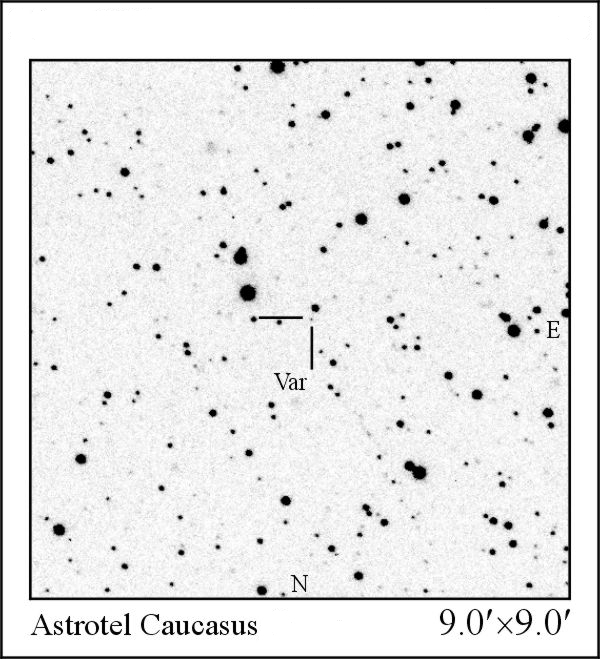| Article in PDF |
"Peremennye Zvezdy", Prilozhenie, vol. 11, N 3 (2011) |
A Transient Event in Perseus
T. Kryachko#1, A. Samokhvalov#2, E. Romas#3, S. A. Korotkiy#4, B. Satovskiy#1
#1. Astrotel Observatory, Karachay-Cherkessia, Russia;
#2. Surgut, Russia;
#3. Kislovodsk Mountain Station, Central Astronomical Observatory of RAS at Pulkovo,
Kislovodsk, Russia;
#4. Ka-Dar Scientific Center and Public Observatory, Moscow, Russia
#2. Surgut, Russia;
#3. Kislovodsk Mountain Station, Central Astronomical Observatory of RAS at Pulkovo, Kislovodsk, Russia;
#4. Ka-Dar Scientific Center and Public Observatory, Moscow, Russia
| ISSN 2221–0474 |
Received: 17.01.2011; accepted: 26.01.2011
(E-mail for contact: bredfild@mail.ru, sav@surgut.ru, romasastro@gmail.com, astro_stas@mail.ru, bs25@mail.ru)
| ||||||||||||||||||||||
Remarks: |
| During observations of a field in Perseus, we discovered a transient event. If it
is an UV-type variable star, its amplitude is unusually large. The nature of the
event might
also be different; note that no gamma-ray bursts were recorded on the date of the
event.
Our observations were carried out at the Astrotel-Caucasus observatory, located at the Astronomical station of the Kazan Federal university, using the 300-mm Ritchey-Chretien telescope, equipped with an unfiltered Apogee Alta U9000 CCD camera. A total of 5 images with 5-minute exposures were obtained on JD 2455538. For basic reductions for dark current, flat fields, bias, and for removing cosmic-ray hits we used IRAF routines. For photometry of the new variable star, we applied MaxIm DL software. The comparison star was USNO-A2.0 1200-02204935 = USNO-B1.0 1210-0058371 (α=04h22m24s.37, δ=+31°03′ 27″.5, J2000, 2MASS), R1=14m.79, R2=14m.76 (USNO-B1.0). Unfiltered magnitudes were calibrated using the comparison star, assuming Rcomp=14m.775. The coordinates of the variable star were measured with respect of stars from the 2MASS catalogue (Skrutskie et al. 2006). The transient event was detected approximately at JD 2455538.3. To determine the variable object's magnitude in quiescence, we took 17 images with 2-minute exposures at the Kislovodsk Mountain Astronomical Station (Pulkovo Observatory, Russian Academy of Sciences) using a 500-mm Maksutov–Cassegrain telescope, equipped with an unfiltered SBIG STL-1001E CCD camera, on JD 2455540. The combined image is shown under the light curve (top right panel). We also used sixteen images with 30-second exposure times from the meteor patrol camera of the Ka-Dar Scientific Center and Public Observatory (Moscow Region), located at the Astronomical station of the Kazan Federal university and equipped with a Canon 20D camera with an F=20 mm 1/1.8 lens, taken on the night of the event. The summed-up image (its mean time being somewhat earlier than the beginning of our CCD observations) is shown below the light curve (bottom left). At the transient's position, an extremely faint star-like image is visible, marked as "Var"; its magnitude is approximately 13m. If this a real detection, the total amplitude of the transient event becomes as large as 8m. To our knowledge, such amplitudes in the red spectral band were never observed for UV Ceti stars. The nature of the faint object found two days later (and also detected in the 2MASS infrared bands, see the image below the light curve, bottom right) at or near the position of the variable object remains unknown. No information is available even on its color indices. We cannot be sure if this is a star or an extended object, for example, a galaxy. Observations with large telescopes are needed to reveal the nature of the transient event we observed. Acknowledgements: We would like to thank N. N. Samus for helpful discussion. |
| References: |
| Skrutskie, M.F., Cutri, R.M., Stiening, R., et al., 2006, AJ, 131, 1163 |
Light Curve
The light curve of the transient and four images of the region around it. Top left: Astrotel Caucasus, star near maximum; top right: Kislovodsk Mountain Station, star in quiescence. Bottom left: the image obtained with the meteor patrol camera of the Ka-Dar Scientific Center and Public Observatory. Bottom right: an image obtained by summing up the 2MASS J, H, and K CCD images; the image shows a rather faint object at the transient's position or very close to it. Finding Chart 
Finding chart based on an Astrotel-Caucasus image. Data Source |